Perhaps the resonance up high was the offender.
I had a jbl 2408h compression driver that drove me from the room
Remember anything at 2.5k has a harmonic of 5k, 7.5k, and 10k, which is bad if you resonate at 10k.....
Or even other intermod products adding up to a frequency at the resonance.
A 10khz notch can't help those 2 situations......
I had a jbl 2408h compression driver that drove me from the room
Remember anything at 2.5k has a harmonic of 5k, 7.5k, and 10k, which is bad if you resonate at 10k.....
Or even other intermod products adding up to a frequency at the resonance.
A 10khz notch can't help those 2 situations......
REW/ miniDSP can be a very powerful combination of tools....and others can "Enabl" the cones.
Thanks Dave, looks like the Sibelius will be hard to beat, with its custom driver and matching enclosure…There were a couple that didn’t take off, Fern & Roby had one. All A10 based IIRC.
dave
I did like the pensil design that I had for a few months.
The morel solstice loudspeaker.............
The morel solstice loudspeaker.............
Last edited by a moderator:
Over here, the costs to professionally build a suitable cabinet ~3k USD for a one off - like that video in post #481.
Sibelius coming in at 8k USD
Sibelius coming in at 8k USD
I missed my chance at a pair of MAOP10 at the Covid trough; then NLA. I would have them up-firing omni, like my A10.3. Plan now is to LX my MAOP5 nude over up-firing MAOP7 with gloss-coated A10.3 as subs.
Last edited:
So long as we can keep the ‘CPI’ >1 😉yea, still below 50% though
Looks like Marlow EV version has frequency balancing circuits to enhance the performance. So, not as simple as putting a driver in a box even if it specifically made for it. Specialist speaker manufacturers will have the edge over diy efforts when it comes to fine tuning …As Chris suggests -the search facility should bring up a few of those train-wrecks. 😉
The Marlowe's response is pretty much as you'd expect for a sub-compact bookshelf with no filtering; the peaking in the ~3 octaves from 350Hz is what you'll usually see (whether it's a single-driver based design or a multiway before [and sometimes after 😉 ] filtering). You end up with a more or less projective response in that region similar to, say, a Yamaha NS10. That's why I did a couple of LS series plans for MA with an optional parallel EQ that's well worth having (for that particular compact box) as you can can tailor the midband response to preference by adjusting the resistor value.
Last week I installed the terminals.
Nice small terminals for doing the job.
Material for the stands I also have.
Nice small terminals for doing the job.
Material for the stands I also have.
Attachments
-
 451957131_10232452988689298_4770007901445707001_n.jpg779.8 KB · Views: 99
451957131_10232452988689298_4770007901445707001_n.jpg779.8 KB · Views: 99 -
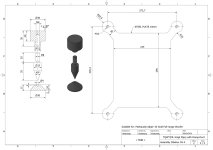 452022757_10232452990049332_8681241793890078630_n.jpg109.6 KB · Views: 113
452022757_10232452990049332_8681241793890078630_n.jpg109.6 KB · Views: 113 -
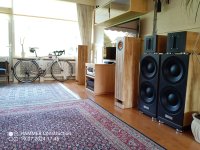 449473480_10232452988249287_1861158547905192339_n.jpg513.4 KB · Views: 112
449473480_10232452988249287_1861158547905192339_n.jpg513.4 KB · Views: 112 -
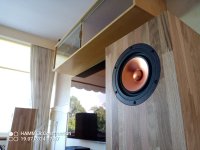 451946334_10232452987369265_8200046609027016612_n.jpg265.1 KB · Views: 118
451946334_10232452987369265_8200046609027016612_n.jpg265.1 KB · Views: 118 -
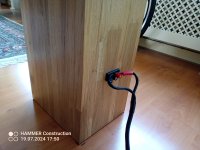 452003369_10232452985249212_3789879537397724936_n.jpg280.6 KB · Views: 111
452003369_10232452985249212_3789879537397724936_n.jpg280.6 KB · Views: 111 -
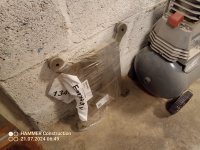 IMG_20240721_064916_875.jpg587.7 KB · Views: 108
IMG_20240721_064916_875.jpg587.7 KB · Views: 108
So, not as simple as putting a driver in a box even if it specifically made for it. Specialist speaker manufacturers will have the edge over diy efforts when it comes to fine tuning …
Not necessarily sir... there are many folks in our DIY community who are capable of challenging "specialist manufacturers" in terms of design and fine tuning. As Scott had alluded to in post #634 of this thread that there are "no secrets, no sauces, just engineering" when it comes to cabinet design and tuning for a driver, the same can be applied to the electrical side of things e.g. filter and crossover networks. 🙂
So with the right approach application of simulations, building and measurements, it should be possible to for the DIYer to come up with very good results, especially given the software and other tools available at reasonably low cost (or sometimes even free). But the effort will have to be put in, and each set of component choices will present their own set of compromises and limitations.
Last week I installed the terminals.
Nice small terminals for doing the job.
Material for the stands I also have.
Good choice of terminals - much less cutting of the rear panel required vs the round terminal cups.
The stand material - that is aluminum or steel plate?
I will use aluminium EN AW-6082 T6 and maybe I'll add a steel spike for the points.
But this aluminium is strong enough already for the points.
But this aluminium is strong enough already for the points.
Thanks @zman01, I was also intrigued by your earlier post on adding some notch filter to smooth out peaks of these FR drivers. Others suggesting DSPs. So, are there any frequency response measurements of say the FHXL or Pensils with drivers installed in this regard. Dr.Scott alluded to some resistors network tweaks for MA drivers. Are these techniques available to diyers to explore?Not necessarily sir... there are many folks in our DIY community who are capable of challenging "specialist manufacturers" in terms of design and fine tuning. As Scott had alluded to in post #634 of this thread that there are "no secrets, no sauces, just engineering" when it comes to cabinet design and tuning for a driver, the same can be applied to the electrical side of things e.g. filter and crossover networks. 🙂
So with the right approach application of simulations, building and measurements, it should be possible to for the DIYer to come up with very good results, especially given the software and other tools available at reasonably low cost (or sometimes even free). But the effort will have to be put in, and each set of component choices will present their own set of compromises and limitations.
Really? Why do you think that? Many people here (including myself, and I'm not the brightest) are perfectly capable of measuring a loudspeaker and designing equalisation circuits to tailor the voicing to achieve a desired set of objectives -as noted, the handful of LS series boxes I've done for Markaudio & can be found on their website in the relevant driver plan sections do precisely that. Same for multiway systems & most other things.Looks like Marlow EV version has frequency balancing circuits to enhance the performance. So, not as simple as putting a driver in a box even if it specifically made for it. Specialist speaker manufacturers will have the edge over diy efforts when it comes to fine tuning …
Last edited:
Can this kind of speaker really play an orchestra anywhere original sound pressure. It seems to have way to little Sd to get anywhere near... using such a limited speaker means that any equipment in the chain can probably not be fully evaluated/utilised/experianced in terms of dynamics and LF extension.
But I'm sure it sounds nice...
//
But I'm sure it sounds nice...
//
- Home
- Loudspeakers
- Full Range
- Pearl Acoustic Sibelius
